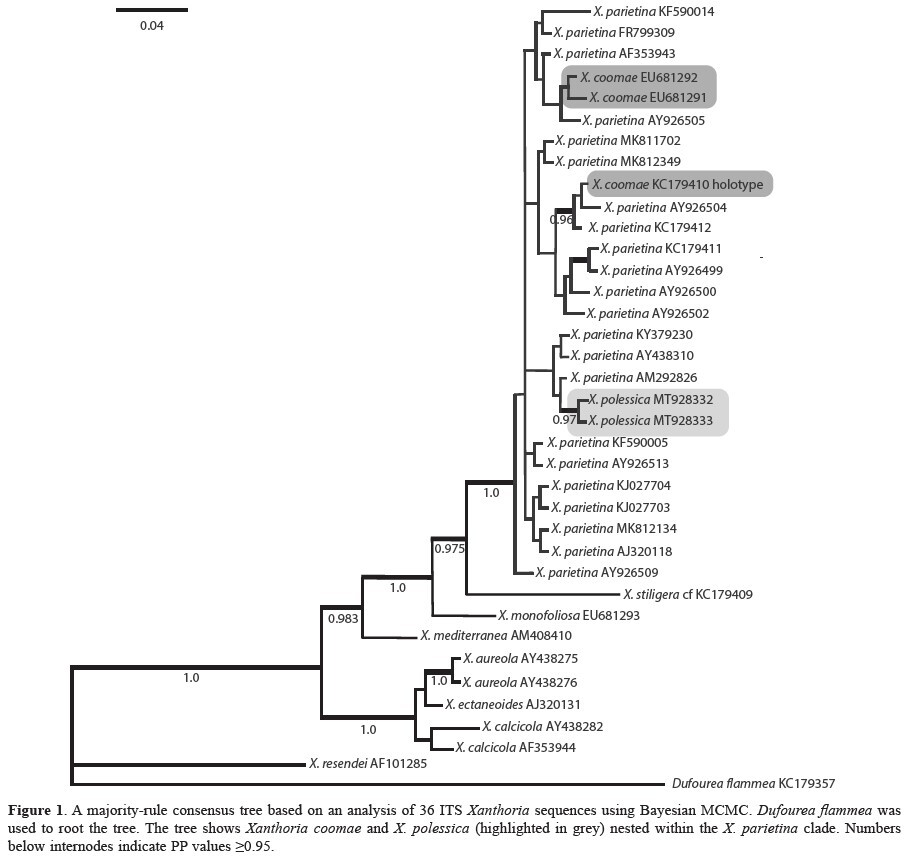ORIGINAL ARTICLE
Molecular phylogenetic analyses reveal two new synonyms
of Xanthoria parietina
1
Department of Biology, Francisk Skorina Gomel State University,
Sovetskaja 104, BY-246019 Gomel, Belarus
2
Department of Ecology, Botany and Nature Protection, Institute of
Natural Sciences, Samara National Research University, Moskovskoye
shosse 34, RU-443086 Samara, Russia
3
Laboratory of Ecological Physiology of Plants, Central Botanical
Garden of the National Academy of Sciences of the Republic of Belarus,
Surganova 2B, BY-220012 Minsk, Belarus
4
Biological Museum, Lund University, Box 117, SE-22100 Lund,
Sweden
Online publication date: 2020-12-29
Publication date: 2020-12-29
Plant and Fungal Systematics 2020; 65(2): 620-623
KEYWORDS
ABSTRACT
Molecular analyses of the recently described Xanthoria polessica collected from
the type locality and of the Australian species X. coomae were used to determine whether
these taxa are distinct species or fall within the wide phenotypic variation of the well-known
and cosmopolitan X. parietina. Our results clearly indicate that both taxa should
be considered as synonyms of X. parietina since the infraspecific morphological range is
accommodated by the observed variation in the thallus and lobe size, their color, position
of apothecia, the shape of ascospores, and width of ascospore septum.
REFERENCES (13)
1.
Arup, U., Søchting, U. & Frödén, P. 2013. A new taxonomy of the family Teloschistaceae. Nordic Journal of Botany 31: 16–83.
2.
Arup, U., Vondrák, J. & Halici, M. G. 2015. Parvoplaca nigroblastidiata, a new corticolous lichen (Teloschistaceae) in Europe, Turkey and Alaska. The Lichenologist 47: 379–385.
3.
Darriba, D., Taboada, G. L., Doallo, R. & Posada, D. 2012. jModelTest 2: more models, new heuristics and parallel computing. Nature Methods 9: 772.
4.
Gardes, M. & Bruns, T. D. 1993. ITS primers with enhanced specificity for basidiomycetes – application for the identification of mycorrhizae and rusts. Molecular Ecology 2: 113–118.
5.
Guindon, S. & Gascuel, O. 2003. A simple, fast and accurate method to estimate large phylogenies by maximum likelihood. Systematic Biology 52: 696–704.
6.
Katoh, K. & Standley, D. M. 2013. MAFFT Multiple Sequence Alignment Software Version 7: Improvements in Performance and Usability. Molecular Biology and Evolution 30: 772–780.
7.
Katoh, K., Misawa, K., Kuma, K. & Miyata, T. 2002. MAFFT: a novel method for rapid multiple sequence alignment based on fast Fourier transform. Nucleic Acid Research 30: 3059–3066.
8.
Kondratyuk, S. Y., Kärnefelt, I., Elix, J. A. & Thell, A. 2007. Contributions to the Teloschistaceae of Australia. Bibliotheca Lichenologica 96: 157–174.
9.
Kondratyuk, S., Yatsyna, A. P., Lőkös, L., Galanina, I., Haji Moniri, M. & Hur, J.-S. 2013. Three new Xanthoria and Rusavskia species (Teloschistaceae, Ascomycota) from Europe. Acta Botanica Hungarica 55: 351–365.
10.
Kondratyuk, S. Y., Upreti, D. K., Mishra, G. K., Nayaka, S., Ingle, K. K., Orlov, O. O., Kondratiuk, A. S., Lőkös, L., Farkas, E., Woo, J.-J. & Hur, J.-S. 2020. New and noteworthy lichen-forming and lichenicolous fungi 10. Acta Botanica Hungarica 62: 69–108.
11.
Lindblom, L. & Ekman, S. 2005. Molecular evidence supports the distinction between Xanthoria parietina and X. aureola (Teloschistaceae, lichenized Ascomycota). Mycological Research 109: 187–199.
12.
Ronquist, F., Teslenko, M., van der Mark, P., Ayres, D. L., Darling, A., Höhna, S., Larget, B., Liu, L., Suchard, M. A. & Huelsenbeck, J. P. 2012. MrBayes 3.2: efficient Bayesian phylogenetic inference and model choice across a large model space. Systematic Biology 61: 539–542.
13.
White, T. J., Bruns, T., Lee, S. & Taylor J. 1990. Amplification and direct sequencing of fungal ribosomal RNA genes for phylogenetics. In: Innis, M. A., Gelfand, D. H., Sninsky, J. J. & White, T. J. (eds). PCR protocols: a guide to methods and applications, pp. 315–322. Academic Press.
CITATIONS (3):
1.
New and Noteworthy Lichen-Forming and Lichenicolous Fungi 13. A Revision of the Xanthoria Ectaneoides Complex (Xanthorioideae, Teloschistaceae) Including the New Species Xanthoria Pylyporlykii
S. Y. Kondratyuk, L. Lőkös, P.-E. Persson, M. Hansson, U. Schiefelbein, I. Kärnefelt, A. Thell
Acta Botanica Hungarica
S. Y. Kondratyuk, L. Lőkös, P.-E. Persson, M. Hansson, U. Schiefelbein, I. Kärnefelt, A. Thell
Acta Botanica Hungarica
2.
New and Noteworthy Lichen-Forming and Lichenicolous Fungi 14. Xanthoria Pedersenii and X. Wennergrenii – Two New Species from the Xanthoria Calcicola Subclade (Xanthorioideae, Teloschistaceae) Proved by Integrative Approach
S. Y. Kondratyuk, L. Lőkös, M. Hansson, U. Schiefelbein, I. Kärnefelt, A. Thell
Acta Botanica Hungarica
S. Y. Kondratyuk, L. Lőkös, M. Hansson, U. Schiefelbein, I. Kärnefelt, A. Thell
Acta Botanica Hungarica
3.
Symbiotic versatility in action: Trebouxia diversity expands the niche of the lichen Xanthoria parietina
Salvador Chiva, Tamara Pazos, Javier Montero-Pau, Patricia Moya, Isaac Garrido-Benavent, Eva Barreno, Lucia Muggia
Salvador Chiva, Tamara Pazos, Javier Montero-Pau, Patricia Moya, Isaac Garrido-Benavent, Eva Barreno, Lucia Muggia
Share
RELATED ARTICLE
We process personal data collected when visiting the website. The function of obtaining information about users and their behavior is carried out by voluntarily entered information in forms and saving cookies in end devices. Data, including cookies, are used to provide services, improve the user experience and to analyze the traffic in accordance with the Privacy policy. Data are also collected and processed by Google Analytics tool (more).
You can change cookies settings in your browser. Restricted use of cookies in the browser configuration may affect some functionalities of the website.
You can change cookies settings in your browser. Restricted use of cookies in the browser configuration may affect some functionalities of the website.



